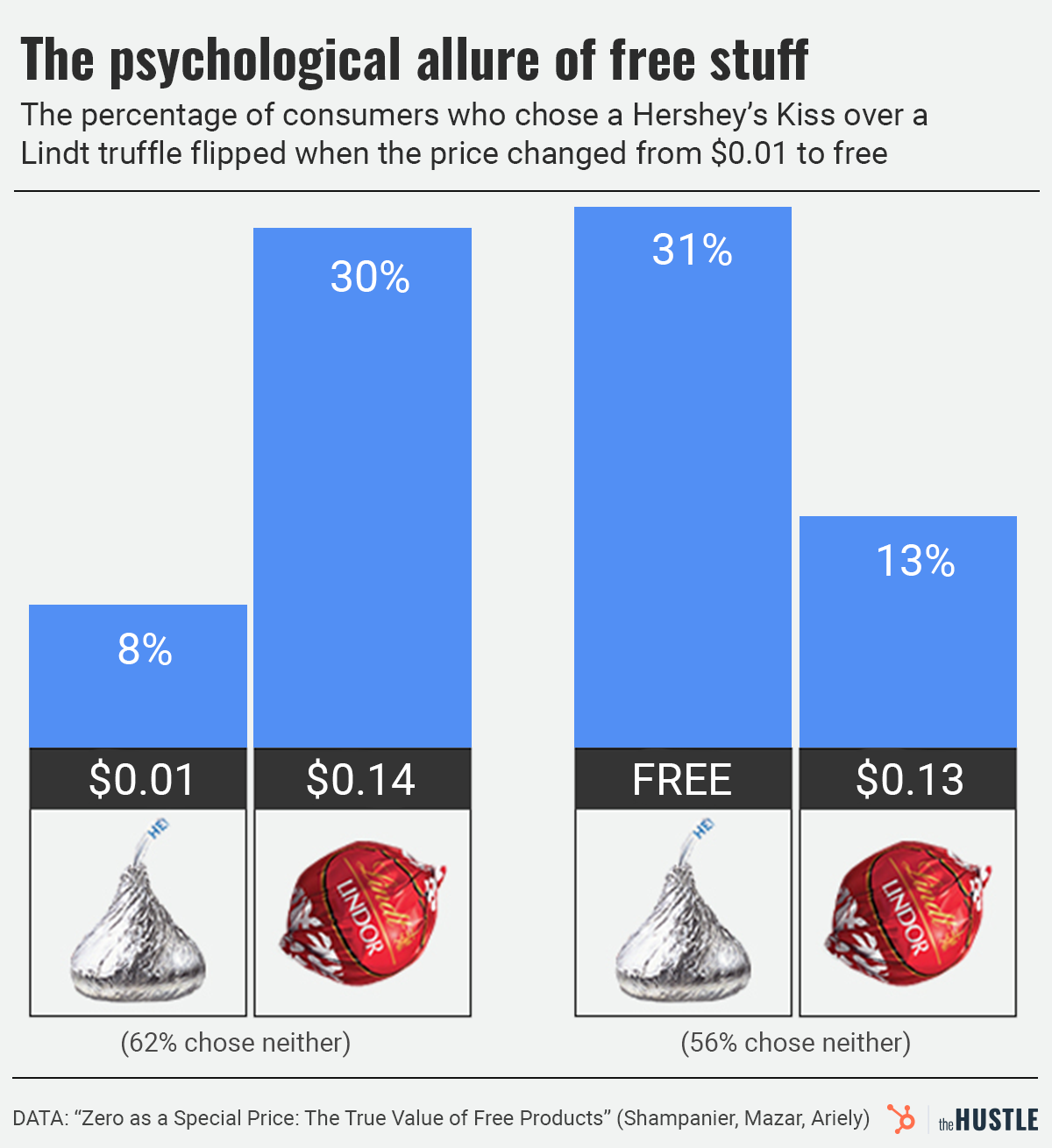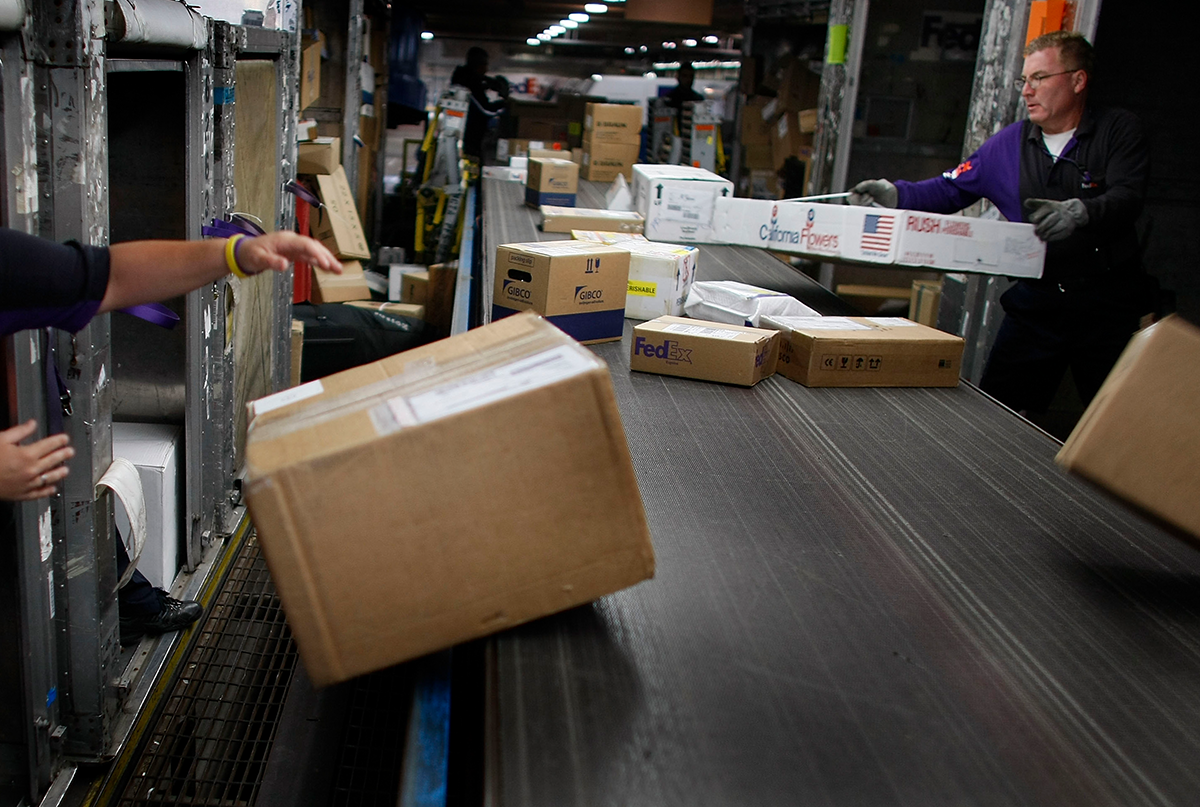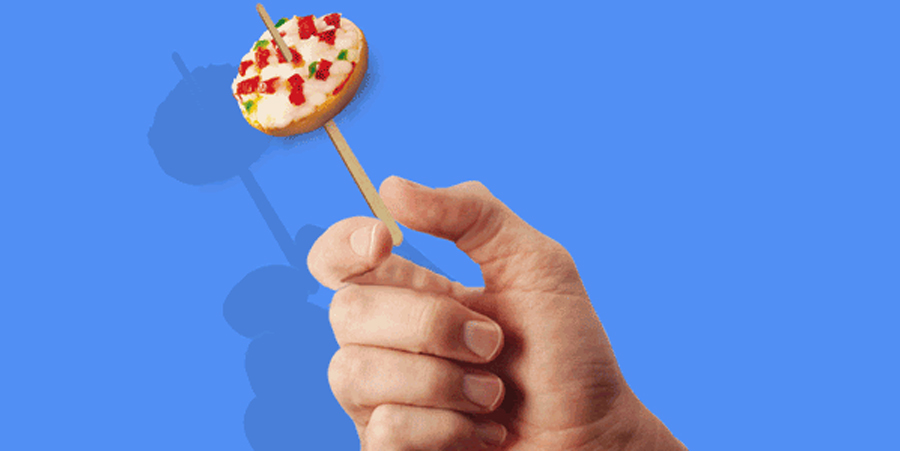When something is free, people feel a positive glow — and standard cost-benefit analyses go out the window.
If you’ve ever wondered just how passionate people are about free samples at Costco, look no further than these 2 incidents:
- 2015: At a Southern California Costco, a 78-year-old was punched in the face after accusing a 24-year-old of hogging too many Nutella waffle samples. An arrest was made.
- 2018: At a South Carolina Costco, 2 septuagenarians on a cheeseburger sample binge got into a spat over line etiquette that ended in a hat-flying slap to the face.
It may seem odd that a few small nibbles on toothpicks would incite violence. But this conduct is rooted in behavioral psychology.
In short, free stuff makes us do very strange, irrational things.
We’ll look at how “free” affects consumer behavior across 3 different areas: grocery store samples, shipping, and online content.
The ‘positive glow’ of not having to pay
Dan Ariely, a professor of behavioral economics at Duke University and the author of Predictably Irrational, has researched the allure of free for years in all kinds of settings.
One time, he even hired somebody to give out free tattoos at a party. People who otherwise may not have considered a tattoo — especially not on a whim — got inked up because the price was right.
“There is something special about being free,” Ariely tells The Hustle.
In 2007, he co-authored a study titled “Zero as a Special Price: The True Value of Free Products” in which participants were asked to choose one of the following:
- A free Hershey’s Kiss
- A $0.13 Lindt truffle (a superior product in quality that retails for multiples more than a Hershey’s Kiss)
More than 2x as many people chose the free Hershey’s Kiss than chose the $0.13 Lindt truffle. But when Ariely and his co-authors put a $0.01 price tag on the Hershey’s Kiss and adjusted the Lindt truffle price by a mere penny, participants overwhelmingly selected the Lindt truffle.

The researchers conducted other experiments involving real chocolates and photos of chocolates, and the results were similar every time.
They dubbed this the zero price effect: People overvalue things that are free and make irrational decisions in many cases when something free is involved.
Kristina Shampanier, a co-author of the study who now works at an economics consulting firm, told The Hustle the behavior is irrational because the research participants who picked the free item gave up something better, something they should prefer in a traditional cost-benefit analysis.
People do it because they are guided by a good feeling — “a positive glow that people have about not having to pay,” according to Shampanier.
As Ariely explains further, when people see something for free, they don’t see the downside.
Most days, we’re not confronted with a choice between free Hershey’s Kisses and inexpensive Lindt chocolates. We do, however, face situations where accepting a free offer feels good but isn’t necessarily the best deal.
Free shipping
According to the 2019 Walker Sands Future of Retail Survey, 77% of 1.6k respondents said free shipping had made them more likely to buy an item online, ranking far above inducements like same-day shipping or the ability to visualize products in 3D.

In a study about free shipping in ecommerce, former Wharton School professor David Bell found that free shipping lulled buyers into financially unsound decisions.
The consumers he studied preferred to save $6.99 and get free shipping, versus saving $10 on the purchase price but still pay for shipping, even though the savings would have been greater.
In addition to the positive glow inherent in the free offer, Ariely says the popularity of free shipping is attractive for another reason. Consumers, he says, have a difficult time understanding why shipping should cost anything:
- They feel OK paying for a tangible product, but they don’t compute how the time and labor involved with shipping should drive up the price.
- The added price of shipping makes them see the total purchase as having an “unfair” cost.
When the “unfair” barrier is removed (by making shipping free), people are more likely to buy the product.

And inexpensive shipping isn’t nearly as effective as free shipping — at least anecdotally.
During Amazon’s early days, the company introduced free shipping in several European countries. In France, it reduced shipping to one franc. While business increased dramatically in the free shipping countries, purchases in France didn’t rise at nearly as high of a rate.
Free samples
When stores like Costco, Sam’s Club, Whole Foods, and Walmart halted free samples at the peak of the pandemic, they had to adjust.
At Walmart, Cure Hydration made a deal for samples of its electrolyte-infused beverage to be featured in curbside pickup orders. Walmart also started offering samples for ecommerce customers.
Why so much trouble for a freebie? It’s simple: Free samples often make people spend money.
To get samples in stores, businesses typically partner with independent companies that staff sampling events and that have relationships with major stores.
Based on 2011 data from The Street, costs for contracting with a demonstration company for one sampling event at a grocery store range from $150 to $340 a day. Companies spend ~$2B a year on free samples.
The returns are usually high, both for the companies looking to sell new products and the stores.
- The former supermarket chain Marsh found 68% of samplers were persuaded to buy a product after sampling.
- A sampling event by one brand leads to higher average sales of brands in the same category that were not part of the sampling event, according to a Brigham Young University study.
When Ziploc sampled a new space bag at Costco, it saw a 156% sales increase. Products in categories like beer, wine, cheese, and frozen pizza have seen increases ranging from 71% to 600%.

Researchers have identified several reasons behind the success of the free samples, from customers gaining familiarity with a product they may have otherwise never tried to customers learning where sampled products are located in the store after sampling them.
But because something free is involved, irrationality is also at play.
The “free” aspect of a free sample causes the same glowing feeling that people experienced with the Hershey’s Kisses, and, Ariely says, people who receive the free sample want to reciprocate.
“You feel obligated to some degree, [making]it more likely you buy the full package,” Ariely says.
But the feeling of reciprocation doesn’t apply everywhere.
Free content
Whether it’s a Substack newsletter or a publication as decorated as The New York Times, many media outlets have readership bases built on giving away a few stories before requiring people to sign up for a subscription.
On the surface, it sounds similar to offering a free sample. So readers should be basking in the glow of a free deal after consuming a couple of articles and then feeling the need to reciprocate, right?
Ariely says the circumstances are different.
- People who read 3 articles for free may want to read another when they bump up against a paywall. But they may see a monthly subscription rate as an expensive price for one more article.
- For food and drink items that get sampled at stores, people are familiar with their regular prices. Because so much content is still free on the internet, people think of online media “in the realm of free.”
Some 20% of Americans pay for online news, according to the Reuters Institute’s Digital News Report for 2020. Their reasons for subscribing are varied, ranging from supporting a specific journalist, to wanting to get ahead in their careers, to believing that paying for news is a societal good.

But ~40% of Americans say they would never pay for news.
Similarly, Ariely says hardly anybody would want to pay for Facebook after being ingrained in its ad-based model for so long.
Yet free content isn’t necessarily the best deal. It’s possible that subscription news sites are higher quality than the free options and also that the free sites — as well as the free version of Facebook we’re accustomed to — include more ads that hook users into paying more money in the long run.
The behavior isn’t rational, a common thread when something free is involved.
Seeking to build and grow your brand using the force of consumer insight, strategic foresight, creative disruption and technology prowess? Talk to us at +971 50 6254340 or engage@groupisd.com or visit www.groupisd.com/story




